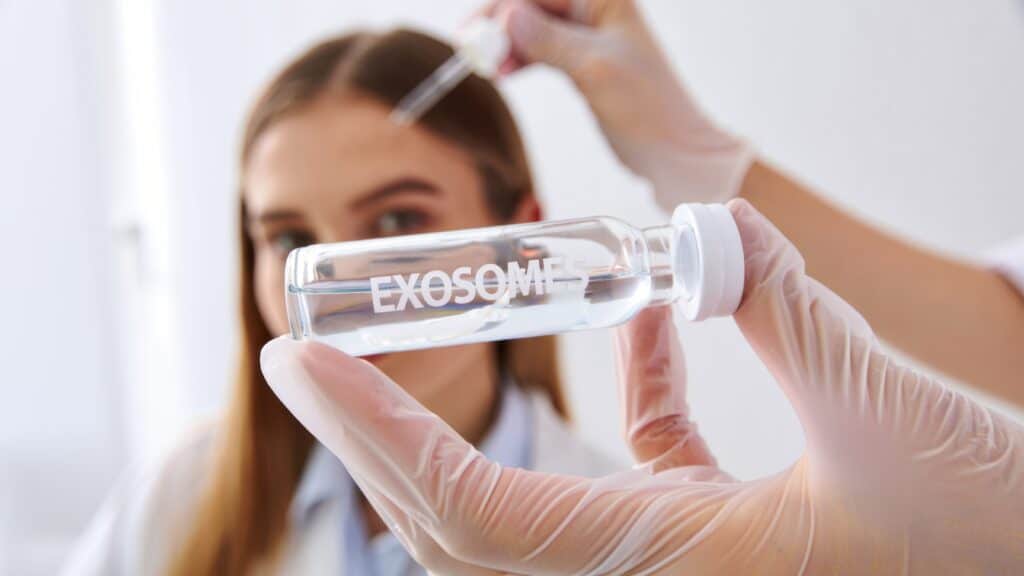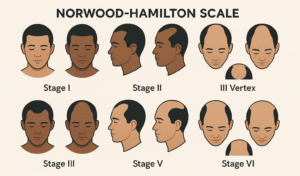Hair loss is a common issue that affects both men and women. For years, hair loss has been addressed with hair transplantation. However, with newly developed treatments, hair loss can now be resolved without the need for surgery. Exosome therapy for hair loss is one such cutting-edge hair loss treatment.
The process uses tiny biological particles called exosomes for stimulated hair follicles. In recent years, this approach has gained attention for its potential in treating hair loss. So today, let’s look at exosome therapy and how it can reduce hair fall and stimulate new hair growth.
What Are Exosomes?
Exosomes are signaling molecules that take the form of tiny balloons called “ extracellular vesicles.” The vesicle cells send information to each other containing something that they want to communicate, like “grow” or “divide,” etc. Exosomes contain a mixture of DNA, RNA, and proteins, and they influence cell behaviour.
There are currently over 95 clinical trials investigating the effects of stem cell exosomes. Exosomes are most interesting when they are derived from mesenchymal stem cells, as these signals may have more potent “stem cell”-like effects. Exosomes used in hair loss therapy are isolated and purified using a proprietary process from donated human amniotic mesenchymal stem cells (MSCs).

What is Exosomes Hair Loss Therapy?
Exosome therapy is a hair loss treatment that uses your own skin cells to regenerate hair follicle stem cells. This is especially useful for people with hair loss genetics who aren’t responding to other therapies. It’s also a great option for people who aren’t interested in undergoing major hair loss treatments.
In this cutting-edge technique, exosomes are injected into the damaged regions of the scalp to encourage hair regrowth. They carry the instructions for cell proliferation, regeneration and signals to initiate cell processes. Exosomes can also extend the growth phase of the hair cycle while reducing the telogen phase.
How Does Exosome Therapy for Hair Loss Work?
Exosome therapy works by microneedling and topically applying exosomes into the open channels of the scalp. These exosomes contain growth factors that enhance follicular activity. The goal is to stimulate hair follicles in areas showing signs of thinning or shedding.
Step-by-step process:
- Assessment and Consultation: The first step is for our medical injectors to carefully check out the health of your scalp and hair.
- Preparation: Mesenchymal stem cells are normally used in a controlled laboratory setting to make the exosomes.
- Injection: Exosomes are microneedled into the parts of the head where hair is thinning as part of the treatment.
- Stimulation: The exosome growth factors help to renew and revitalize the hair shafts, which starts the hair growth cycle and makes it last longer.
Exosomes may improve cellular signaling and help the microenvironment of the scalp, according to a study. Because of this, it can help wake up dormant follicles in people with early-stage androgenetic alopecia.
How Effective Is Exosome Hair Treatment?
Exosomes can help the body heal itself without taking blood, which makes it a less invasive choice. The results usually depend on how the hair is falling out and how healthy the donor area is in transplant cases.
Exosome therapy can be used on its own for some people, while for others it may be paired with other treatments like platelet-rich plasma (PRP) therapy.
Exosome treatment has a number of advantages, such as:
- Promote hair growth and healing for the follicles.
- There are no cuts or general anesthesia in this process, so it is not surgical.
- An easy and risk-free process.
- Keeping hair healthy and strong and stopping hair loss.
- Easy to use by injecting, which leads to fast healing.
- Normal hair growth.
- Less irritation and inflammation in the head
- Better value for money than hair transplants.
- Offers a long-lasting answer to hair loss.
Are There Side Effects or Safety Concerns?
No, Exosome hair restoration is a safe and well-tolerated treatment. The exosomes are processed to remove impurities, reducing the risk of adverse reactions.
Possible mild side effects may include:
- Some irritation and redness
- A small percentage may develop slight swelling and/or bruising at the injection sites
- Mild scalp tenderness
- Itching during the healing phase
There is no risk of disease transmission, allergy, or immunological reaction because platelets and exosomes are derived from your own blood. However, with any medical treatment, it is important to consult experts to discuss any concerns.

Who Is a Good Candidate for Exosomes for Hair?
Exosome therapy for hair loss may be suitable for:
- Men and women who are in the early stages of hair thinning or androgenetic alopecia.
- A healthy scalp responds better to treatment. A healthy scalp means free of infection, inflammation, or skin disorders.
- Patients looking to enhance results from hair transplant Turkey before and after procedures.
- If you are looking for non invasive procedures or an alternative to surgery.
- If you have already tried PR but want additional regenerative benefits.
Exosome hair therapy is not ideal for:
- Completely bald areas where hair follicles have been inactive for years.
- If you are suffering from conditions like seborrheic dermatitis, psoriasis, or scalp infections.
Free Consultation!
Benefit from Dr. Acar’s experience in hair implants to achieve your dream result!
Alternatives to Exosome Hair Treatment
If exosome therapy is not suitable, there are other hair loss treatment options:
- Platelet Rich Plasma (PRP): While both exosomes and PRP use growth factors to encourage hair growth, they target different body components. Exosomes target existing stem cells in the scalp, whereas PRP stimulates tissue repair and regeneration. In contrast to PRP hair loss treatment, users only need to go through one session per treatment cycle with Exosome therapy. Results are usually visible after 3 months.
- Low-Level Laser Therapy (LLLT): It uses red light to stimulate hair growth and it is effective for early-to-moderate hair loss, but requires consistent use at home. The results are usually slower, taking three to six months of consistent use. Exosome therapy can offer faster results (2–3 months) but is more invasive, and expensive.
- Hair Transplant Surgery: A hair transplant surgery is a permanent solution for hair loss. In the procedure, a surgeon relocates hair roots from the donor area to thinning areas. However, exosome therapy stimulates existing hair follicles.
At Cosmedica Clinic, Dr. Levent Acar often uses hair follicle growth–stimulating treatments like PRP or exosomes alongside hair transplant for best possible result.
Final Thoughts
Exosome therapy for hair loss is a new and exciting development in regenerative medicine. By using exosomes derived from mesenchymal stem cells, this treatment may stimulate hair follicles, and slow the progression of androgenetic alopecia.
Exosome therapy is a promising non-invasive treatment option. Combining exosome therapy with PRP or oral treatments can be a great way for treating hair loss. For more information on exosome therapy, you can check out Cosmedica Clinic in Istanbul, Turkey for advanced care and restored confidence.




